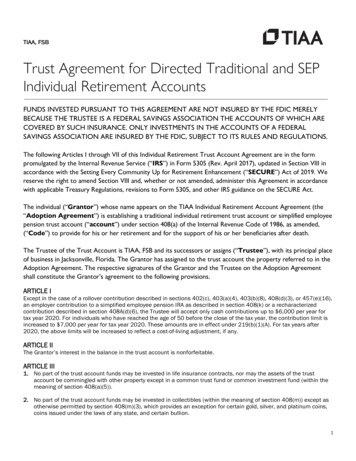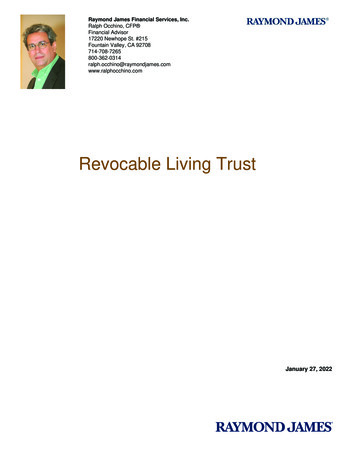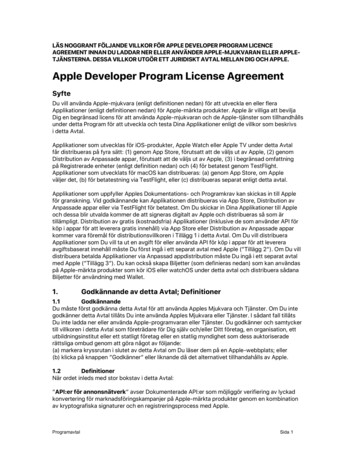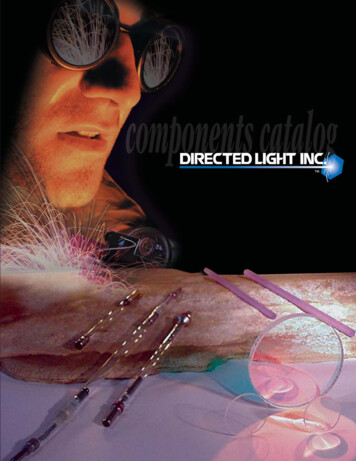
Transcription
TIAA, FSBTrust Agreement for Directed Traditional and SEPIndividual Retirement AccountsFUNDS INVESTED PURSUANT TO THIS AGREEMENT ARE NOT INSURED BY THE FDIC MERELYBECAUSE THE TRUSTEE IS A FEDERAL SAVINGS ASSOCIATION THE ACCOUNTS OF WHICH ARECOVERED BY SUCH INSURANCE. ONLY INVESTMENTS IN THE ACCOUNTS OF A FEDERALSAVINGS ASSOCIATION ARE INSURED BY THE FDIC, SUBJECT TO ITS RULES AND REGULATIONS.The following Articles I through VII of this Individual Retirement Trust Account Agreement are in the formpromulgated by the Internal Revenue Service (“IRS”) in Form 5305 (Rev. April 2017), updated in Section VIII inaccordance with the Setting Every Community Up for Retirement Enhancement (“SECURE”) Act of 2019. Wereserve the right to amend Section VIII and, whether or not amended, administer this Agreement in accordancewith applicable Treasury Regulations, revisions to Form 5305, and other IRS guidance on the SECURE Act.The individual (“Grantor”) whose name appears on the TIAA Individual Retirement Account Agreement (the“Adoption Agreement”) is establishing a traditional individual retirement trust account or simplified employeepension trust account (“account”) under section 408(a) of the Internal Revenue Code of 1986, as amended,(“Code”) to provide for his or her retirement and for the support of his or her beneficiaries after death.The Trustee of the Trust Account is TIAA, FSB and its successors or assigns (“Trustee”), with its principal placeof business in Jacksonville, Florida. The Grantor has assigned to the trust account the property referred to in theAdoption Agreement. The respective signatures of the Grantor and the Trustee on the Adoption Agreementshall constitute the Grantor’s agreement to the following provisions.ARTICLE IExcept in the case of a rollover contribution described in sections 402(c), 403(a)(4), 403(b)(8), 408(d)(3), or 457(e)(16),an employer contribution to a simplified employee pension IRA as described in section 408(k) or a recharacterizedcontribution described in section 408A(d)(6), the Trustee will accept only cash contributions up to 6,000 per year fortax year 2020. For individuals who have reached the age of 50 before the close of the tax year, the contribution limit isincreased to 7,000 per year for tax year 2020. These amounts are in effect under 219(b)(1)(A). For tax years after2020, the above limits will be increased to reflect a cost-of-living adjustment, if any.ARTICLE IIThe Grantor’s interest in the balance in the trust account is nonforfeitable.ARTICLE III1. No part of the trust account funds may be invested in life insurance contracts, nor may the assets of the trustaccount be commingled with other property except in a common trust fund or common investment fund (within themeaning of section 408(a)(5)).2. No part of the trust account funds may be invested in collectibles (within the meaning of section 408(m)) except asotherwise permitted by section 408(m)(3), which provides an exception for certain gold, silver, and platinum coins,coins issued under the laws of any state, and certain bullion.1
ARTICLE IV1. Notwithstanding any provision of this agreement to the contrary, the distribution of the Grantor’s interest in the trustaccount shall be made in accordance with the following requirements and shall otherwise comply with section408(a)(6) and the regulations thereunder, the provisions of which are herein incorporated by reference.2. The Grantor’s entire interest in the trust account must be, or begin to be, distributed not later than the Grantor’srequired beginning date, April 1 following the calendar year in which the Grantor reaches age 72.By that date, the Grantor may elect, in a manner acceptable to the Trustee, to have the balance in the trust accountdistributed in:a. a single sum orb. payments over a period not longer than the Grantor’s life or the joint lives of the Grantor and his or herdesignated beneficiary.3. If the Grantor dies before his or her entire interest is distributed to him or her, the remaining interest will bedistributed as follows:a. If the Grantor dies on or after the required beginning date and:i. The designated beneficiary is the Grantor’s surviving spouse, the remaining interest will be distributed overthe surviving spouse’s life expectancy as determined each year until such spouse’s death, or over the periodin paragraph (a)(iii) below if longer. Any interest remaining after the spouse’s death will be distributed oversuch spouse’s remaining life expectancy as determined in the year of the spouse’s death and reduced by 1for each subsequent year, or, if distributions are being made over the period in paragraph (a)(iii) below, oversuch period.ii.The designated beneficiary is not the Grantor’s surviving spouse, the remaining interest will be distributedover the beneficiary’s remaining life expectancy as determined in the year following the Grantor’s death andreduced by 1 for each subsequent year, or over the period in paragraph (a)(iii) below if longer.iii. There is no designated beneficiary, the remaining interest will be distributed over the remaining lifeexpectancy of the Grantor as determined in the year of the Grantor’s death and reduced by 1 for eachsubsequent year.b. If the Grantor dies before the required beginning date, the remaining interest will be distributed in accordancewith (i) below or, if elected or there is no designated beneficiary, in accordance with (ii) below:i.The remaining interest will be distributed in accordance with paragraphs (a)(i) and (a)(ii) above (but not overthe period in paragraph (a)(iii), even if longer), starting by the end of the calendar year following the year ofthe Grantor’s death. If, however, the designated beneficiary is the Grantor’s surviving spouse, then thisdistribution is not required to begin before the end of the calendar year in which the Grantor would havereached age 72.But, in such case, if the Grantor’s surviving spouse dies before distributions are required to begin, then theremaining interest will be distributed in accordance with (a)(ii) above (but not over the period in paragraph(a)(iii), even if longer), over such spouse’s designated beneficiary’s life expectancy, or in accordance with (ii)below if there is no such designated beneficiary.ii.The remaining interest will be distributed by the end of the calendar year containing the fifth anniversary ofthe Grantor’s death.4. If the Grantor dies before his or her entire interest has been distributed and if the designated beneficiary is not theGrantor’s surviving spouse, no additional contributions may be accepted in the trust account.5. The minimum amount that must be distributed each year, beginning with the year containing the Grantor’s requiredbeginning date, is known as the “required minimum distribution” and is determined as follows:a. The required minimum distribution under paragraph 2(b) for any year, beginning with the year the Grantorreaches age 72, is the Grantor’s trust account value at the close of business on December 31 of the precedingyear divided by the distribution period in the uniform lifetime table in Regulations section 1.401(a)(9)-9.However, if the Grantor’s designated beneficiary is his or her surviving spouse, the required minimum2
distribution for a year shall not be more than the Grantor’s trust account value at the close of business onDecember 31 of the preceding year divided by the number in the joint and last survivor table in Regulationssection 1.401(a)(9)-9. The required minimum distribution for a year under this paragraph (a) is determinedusing the Grantor’s (or, if applicable, the Grantor and spouse’s) attained age (or ages) in the year.b. The required minimum distribution under paragraphs 3(a) and 3(b)(i) for a year, beginning with the yearfollowing the year of the Grantor’s death (or the year the Grantor would have reached age 72, if applicable underparagraph 3(b)(i)) is the trust account value at the close of business on December 31 of the preceding yeardivided by the life expectancy (in the single life table in Regulations section 1.401(a)(9)-9) of the individualspecified in such paragraphs 3(a) and 3(b)(i).c.The required minimum distribution for the year the Grantor reaches age 72 can be made as late as April 1 of thefollowing year. The required minimum distribution for any other year must be made by the end of such year.6. The owner of two or more Traditional IRAs may satisfy the minimum distribution requirements described above bytaking from one traditional IRA the amount required to satisfy the requirement for another in accordance with theregulations under section 408(a)(6).ARTICLE V1. The Grantor agrees to provide the Trustee with all information necessary to prepare any reports required undersection 408(i) and Regulations sections 1.408-5 and 1.408-6.2. The Trustee agrees to submit to the Internal Revenue Service (IRS) and the Grantor the reports prescribed by theIRS.ARTICLE VINotwithstanding any other articles which may be added or incorporated, the provisions of Articles I through III and thissentence will be controlling. Any additional articles inconsistent with section 408(a) and the related regulations will beinvalid.ARTICLE VIIThis agreement will be amended as necessary to comply with the provisions of the Code and the related regulations.Other amendments may be made with the consent of the persons whose signatures appear on the Adoption Agreement.ARTICLE VIIIAll of the provisions set forth in this document entitled “Additional Provisions Applicable to TIAA Trusteed IRAs” shall alsoapply to this Agreement and are incorporated herein by this reference for all purposes, unless otherwise stated therein.ADDITIONAL PROVISIONS APPLICABLE TO TIAA TRUSTEED IRAS1. Definitions.a. “Trust Account,” or “IRA” shall mean the Directed Traditional or SEP Individual Retirement Trust Accountestablished hereunder for the benefit of the Grantor and/or his or her Beneficiary(ies).b. “Adoption Agreement,” “Account Application,” or “Application,” shall mean the Application by which this TrustAccount is established by the agreement between the Grantor and the Trustee.c.“Agreement” shall mean (i) the TIAA Directed Traditional or SEP Individual Retirement Account Trust Agreement;(ii) the TIAA Directed Traditional or SEP Individual Retirement Account Disclosure Statement; (iii) the Terms andConditions – TIAA Retirement Reserves; and (iv) the information and provisions set forth in the AdoptionAgreement for the IRA, as well as any effective Beneficiary Designation applicable to the Trust Account, as any ofthe same may be amended from time to time.d. “Beneficiary” shall mean the person(s), or entity(ies), (for instance, a trust), designated from time to time by aGrantor or a Grantor’s surviving spouse to receive benefits by reason of the death of the Grantor or of suchspouse, or the person(s) described in Section 7 below who would otherwise be entitled to receive such benefits.e. “Code” or “Internal Revenue Code” shall mean the Internal Revenue Code of 1986, as amended from time totime.3
f.“Grantor” shall mean the Grantor and an individual who adopts the IRA and who makes contributions or onwhose behalf contributions are made to his or her Trust Account pursuant to the IRA.g.“Simplified Employee Pension Account” shall mean a Trust Account established by a Grantor whose employerhas adopted a simplified employee pension IRA pursuant to Code section 408(k).h. “Sponsor” shall mean Teachers Insurance and Annuity Association of America.i.“Spouse” shall mean a person who meets the definition of spouse under federal law. IRS guidance provides thatcivil unions and domestic partnerships that may be recognized under state law are not marriages unlessdenominated as such.j.“Trustee” shall mean TIAA, FSB, its successors and assigns, and any successor Trustee qualified to serve insuch capacity with respect to IRA assets under applicable law and regulations, which has accepted to serve astrustee of the Trust Account.2. Grantor’s Representations. The Grantor acknowledges and represents to the Trustee as follows:a. The Grantor has been advised that the entirety of this Agreement has not been approved by the InternalRevenue Service (“IRS”).b. The Grantor has been advised that the Trustee does not make warranties or in any way represent that theGrantor will qualify for all or any portion of the retirement savings deductions under the Code with respect toTraditional IRAs, that earnings of the Trust Account will be exempt from taxation, that any rollover contributionwill be excludable from gross income for tax purposes, or that the Grantor will be free of any penalty taxes whichmay be incurred as a result of his or her failure to comply with the laws and regulations applicable to TraditionalIRAs.c.The Grantor is eligible for a Traditional IRA and the contributions to be made thereto will be made in accordancewith applicable laws and regulations. The Grantor is responsible for all fines and assessments, and for anyadverse tax consequences, which may be imposed on the Grantor by applicable law. The Trustee assumes noliability whatsoever for tax implications associated with this Agreement.d. Any information the Grantor has provided or will provide to the Trustee with respect to this Agreement iscomplete and accurate. The Grantor will inform the Trustee of any change in any such information that couldaffect the efficient administration of the Trust Account. Such information includes, but is not limited to, a changein mailing or residence address, a change in beneficiary, and a change in the Grantor’s tax year forcontributions. Any direction given by the Grantor to the Trustee, or any action taken by the Grantor, will beproper under this Agreement and applicable law. The Trustee shall have the right to rely upon any informationfurnished by the Grantor (or any Beneficiary following the Grantor’s death). The Grantor hereby agrees that theTrustee will not be liable for any loss or expense resulting from any action taken or determination made inreliance on such information. The Trustee will not be responsible for the Grantor’s actions or failures to act.Likewise, the Grantor will not be responsible for the Trustee’s actions or failures to act; provided, however, thatthe Trustee’s duties and responsibilities under this Agreement are limited to those specifically stated in theAgreement, and no other or further duties or responsibilities will be implied.3. Notices and Change of Address. Any notice required to be provided by the Trustee regarding this Trust Account willbe considered effective when mailed by the Trustee to the last address of the intended recipient as reflected in theTrustee’s records. The last address of the Grantor as reflected in the records of the Trustee will be the address usedfor any tax withholding, disbursement, and reporting required by taxing authorities. The Grantor will notify theTrustee of any change of address in writing. Any notice to be given to the Trustee will be effective following theTrustee’s receipt thereof and its reasonable opportunity to act thereon.4. Contributions.a. Excess Contributions. The Grantor is responsible for the determination of any excess contributions and thetimely withdrawal thereof. If the IRS or the Grantor notifies the Trustee in writing that the contributions to theTrust Account have exceeded the contribution limitations described in Article I of the IRA, the Trustee shalldistribute to the Grantor from the Trust Account the amount of such excess contribution and, as determined bythe Grantor, any income attributable thereto. The Grantor may revoke such notice in writing if the IRS has notnotified the Trustee of the IRS’ determination that the excess contribution was willfully made by the Grantor. The4
Trustee, at the request of the Grantor, may credit as a contribution for the current taxable year the amountshown in the notice of the Grantor revoking his or her prior notification.b. Regular IRA Contributions Deadlines. The last day to make annual IRA contributions for a particular tax year isthe deadline for filing the Grantor’s federal income tax return, not including extensions, or such later date asmay be determined by the Department of the Treasury or the IRS for the taxable year for which the contributionrelates. The Grantor shall designate, in a form and manner acceptable to the Trustee, the taxable year for whichsuch contribution is made.c.Contributions to a Traditional IRA for a spouse. Contributions to a Traditional IRA for a spouse must becontributed to a separate Traditional IRA trust account, as applicable, established by such spouse, and suchspouse shall thereafter be deemed to be the Grantor with respect to such separate trust account.5. Investment of Contributions.a. Direction by Grantor. Unless the Grantor appoints a representative to provide directions to the Trustee withrespect to the investment of assets in the Trust Account, as provided in paragraph d, of this section, the Grantorshall direct the Trustee with respect to the investment of all contributions to his or her Trust Account and theearnings thereon. Such directed investments shall be limited to publicly traded securities, mutual funds,exchange-traded funds, money market instruments, bank products, other funding vehicles offered as part of thisIRA at the discretion of the Sponsor and Trustee, and other investments to the extent that they may be subjectto the custody of the Trustee in the Trustee’s regular course of business and are otherwise acceptable by theTrustee based on the Trustee’s policies and operational requirements. Accordingly, the Trustee reserves theright not to accept assets intended for deposit to the Trust Account (whether initially contributed or subsequentlyacquired), including assets not publicly traded and/or easily valued. The Trustee may at any time requireliquidation or transfer of any asset held in the Trust Account if the Trustee determines that maintaining custodyof any such asset is not in accordance with the Trustee’s policies or operational requirements.In its capacity as trustee, the Trustee shall have no investment authority over the Trust Account, including in theabsence of investment directions by or on the Grantor’s behalf. All transactions directed by the Grantor shall besubject to the rules, regulations, customs, and usages of the exchange, market, or clearing house whereexecuted, to applicable federal and state laws and regulations, and to the Trustee’s policies and operationalrequirements.The Grantor understands that (i) the Trustee shall attribute earnings only to assets held in the Trust Accountwhile in the custody of the Trustee; (ii) the income from, and gain or loss on, each investment the Grantorselects and directs for the Trust Account will affect the value thereof; and (iii) the growth in value of a TrustAccount cannot be guaranteed or projected.b. Direction by Beneficiary. Subject to the standard practices of the Trustee, if the Grantor dies before part or all ofhis or her interest in the Trust Account is distributed to him or her, the remaining assets in the Trust Accountshall be invested as directed by the Grantor’s Beneficiary(ies). In such event, the Beneficiary(ies) shall betreated as the Grantor for all purposes as though to the Beneficiary(ies) had entered into this Agreement.c.No Duty to Review. The Trustee shall not be under any duty to review or question any direction of the Grantor orthe Grantor’s representative with respect to investments, to review any securities or other property held in theTrust Account, or to make suggestions to the Grantor with respect to investments. The Trustee will not be liablefor any loss that may result by reason of investments made by the Trustee in accordance with the directions ofthe Grantor or the Grantor’s representative.d. Delegation of Investment Responsibility. Regardless of any other provision of this Agreement to the contrary, theGrantor may appoint an investment professional or other person to act as the Grantor’s representative withauthority to direct the Trustee with respect to the investment of assets in the Trust Account. Such appointmentwill be effective only if (1) the Trustee has received an executed copy of an agreement between the Grantor andthe representative in a form and manner acceptable to the Trustee that specifies the authority of therepresentative to act on behalf of the Grantor; and (2) the Trustee does not object to acting on the direction ofsuch representative, which objection the Trustee may assert for any reason at any time. If the Grantor appointsa representative, as provided above, references to the Grantor in this Agreement (to the extent such referencespertain to securities with respect to which such representative has investment authority) shall includereferences to such representative. However, all references in this Agreement to the individual whose TrustAccount is involved and to the making of contributions and the receipt of distributions are only to the Grantor.5
The Grantor may revoke the authority of any such representative at any time by notifying the Trustee in writingand otherwise in a manner acceptable to the Trustee. The Trustee shall not be liable in any way for transactionsinitiated prior to and up to the time of the Trustee’s receipt of such notice and its reasonable opportunity to actthereon.e. Investment of Cash Balances. Absent another instructions from you, assets received in cash shall be invested inthe TIAA Retirement Reserves Account. You have the right to move funds to other available investments at anytime. Any IRA funds in the TIAA Retirement Reserves Account are held at the Bank, which is a member of theFDIC. Cash balances in the Cash Deposit Account are FDIC-insured up to 250,000 per account holder,combined with other insured deposits of the account holder at the Bank in the same ownership category.The Grantor’s Trust Account may include a sweep program feature which automatically transfers at the end ofeach business day available uninvested cash balances in the Grantor’s Trust Account to certain funding vehicles(each, a “Sweep Vehicle”). The Grantor authorizes and directs the Trustee to deposit uninvested cash balancesin demand deposits or similar accounts maintained in the commercial or savings department of any bank orsavings association, the deposits of which are insured by the Federal Deposit Insurance Corporation (“FDIC”),including those of the Trustee or any bank or savings association that is an affiliate of the Trustee; provided thatany such deposits bear a reasonable rate of interest. The Grantor directs and authorizes the Trustee towithdraw, transfer in-kind or liquidate out of any discontinued Sweep Vehicle Grantor’s funds or shares anddeposit or transfer such funds or shares into any other Sweep Vehicle then offered by the Trustee. The Grantorfurther directs the Trustee to automatically withdraw or redeem the cash held in such Sweep Vehicle to meet theGrantor’s cash needs for the settlement of transactions, payment of distributions or as otherwise necessary.Additional terms and conditions applicable to a Sweep Vehicle are described in the disclosures andsupplemental agreements associated with such Sweep Vehicle.6. Withdrawals.a. Request and Distribution. The Grantor (and the Beneficiaries after the Grantor’s death) may withdraw all or partof his or her Trust Account balance at any time. All requests for withdrawal (i) shall be in a form and mannerprovided by or acceptable to the Trustee; (ii) shall be deemed to constitute a certification by the Grantor that theGrantor is permitted to receive the funds directed to be withdrawn; and (iii) shall be subject to all applicable taxand other laws and regulations, including possible early withdrawal penalties and withholding requirements.Notwithstanding any other provision of this Agreement to the contrary, the Trustee assumes (and shall have) noresponsibility to make any distribution to the Grantor unless and until such instructions specify the occasion forsuch requested withdrawal. Prior to effectuating any such withdrawal from the Trust Account, the Trustee shallbe furnished with any and all applications, certificates, tax waivers, signature guarantees, and other documents(including proof of any legal representative’s authority) deemed necessary or advisable by the Trustee. TheTrustee shall not be liable for complying with instructions which appear to be genuine, or for refusing to complyif the Trustee is not satisfied that such instructions are genuine, and assumes (and shall have) no duty of furtherinquiry. The Grantor shall provide such instructions within a reasonable period prior to the date the withdrawal isrequested to be made. After receipt of proper instructions as required above and a reasonable opportunity toact thereon, the Trustee shall cause the assets of the Trust Account to be distributed in cash and/or in kind, asspecified in such order. If payment is made outside of the United States, special federal income tax withholdingrules may apply. Distributions to the Grantor from the IRA may be made in a single sum, periodic payment, or acombination of both.b. Required Distributions. The Trustee shall, if requested by the Grantor, be responsible for computing the requiredminimum distribution amount in accordance with Article IV of this IRA Trust Agreement, and for notifying theGrantor accordingly. The Grantor shall be responsible for causing the required minimum distribution amount tobe withdrawn from his or her Trust Account each year. Notwithstanding anything in Article IV to the contrary, theTrustee shall not, without the consent of the Grantor, distribute the value of the required minimum distributionwhere the Grantor fails to choose any method of distribution by April 1st of the year following the year theGrantor reaches age 72.7. Designations of Beneficiaries. A Grantor may designate a Beneficiary or Beneficiaries of the Trust Account at anytime, and any such designation may be changed or revoked at any time, by written designation executed by theGrantor in a form and manner prescribed by or acceptable to, and filed with, the Trustee. Such designation, change,or revocation shall be effective only upon receipt by the Trustee and only if such receipt shall be during the Grantor’slifetime. The latest such designation, change, or revocation shall control. If there is no Beneficiary designation on filewith the Trustee, or if the designated Beneficiary(ies) has (have) not survived the Grantor, the Trustee shalldistribute the Trust Account to the survivors of the Grantor in the following order of preference:6
1. The Grantor’s surviving spouse, if any;2. The Grantor’s children, if any, in equal shares per stirpes;3. The Grantor’s estateIf the Grantor designates more than one primary or contingent Beneficiary but does not specify the percentages towhich such Beneficiary or Beneficiaries are entitled, payment will be made to the surviving Beneficiary orBeneficiaries in equal shares. Unless otherwise designated by the Grantor in a form and manner acceptable to theTrustee (i) if a primary or contingent Beneficiary designated by the Grantor predeceases the Grantor, the Account willbe divided equally among the surviving Beneficiary or Beneficiaries; (ii) if there is no primary Beneficiary orBeneficiaries living at the time of the Grantor’s death, payment of the Grantor’s Account upon his or her death willbe made to the surviving contingent Beneficiary or Beneficiaries designated by the Grantor; (iii) if a Beneficiary doesnot predecease the Grantor but dies before receiving his or her entire interest in the Trust Account, his or herremaining interest in the Trust Account shall be paid to the Beneficiary or Beneficiaries designated by the deceasedBeneficiary.Following the death of the Grantor, the balance of the Grantor’s Trust Account shall be distributed to the Grantor’sdesignated Beneficiary(ies), if any, in accordance with the provisions of Article IV of this IRA Trust Agreement and inaccordance with this Agreement and the Trustee’s policies and operational requirements.8. Distributions to Beneficiaries. The primary Beneficiary(ies) designated by the Grantor will receive the balance of theTrust Account following the Grantor’s death in the percentage indicated by the Grantor. If any primary Beneficiarypredeceased the Grantor, the deceased Beneficiary’s share will instead be distributed to the remaining primaryBeneficiary(ies) equally, or in the proportion the Grantor may have indicated. If all of the Grantor’s primaryBeneficiaries predecease the Grantor, or if the Grantor failed to name any primary Beneficiary, but namedcontingent Beneficiaries, the balance of the Trust Account will be distributed to the contingent Beneficiaries namedby the Grantor, if any, in the percentage indicated by the Grantor. The foregoing rules applicable with respect toprimary Beneficiaries are also applicable with respect to contingent Beneficiaries. If all of the designatedBeneficiaries predecease the Grantor, the balance of the assets in the Trust Account will be distributed to theGrantor’s estate.At any time, any Beneficiary may designate his or her own Beneficiary(ies) (“Successor Beneficiaries”) of theBeneficiary’s interest in the Trust Account, and any such designation may be changed or revoked at any time bywritten designation executed by the Beneficiary in a form and manner prescribed by, or acceptable to, and filed with,the Trustee. If a Beneficiary does not predecease the Grantor but dies before receiving his or her entire interest inthe Trust Account, his or her remaining interest in the Trust Account shall be paid to the successor Beneficiary(ies). Ifthere is no accepted successor beneficiary designation on file with the Trustee, the Trustee shall distribute thedeceased Beneficiary’s Trust Account to the Ben
An IRA will be established upon your execution of the TIAA Individual Retirement Account Adoption Agreement. You will need to designate in the Adoption Agreement if you are establishing a Traditional IRA or a SEP IRA. The Bank reserves the right to amend the IRA Agreement as necessary to maintain the tax-qualified status of your IRA and as










